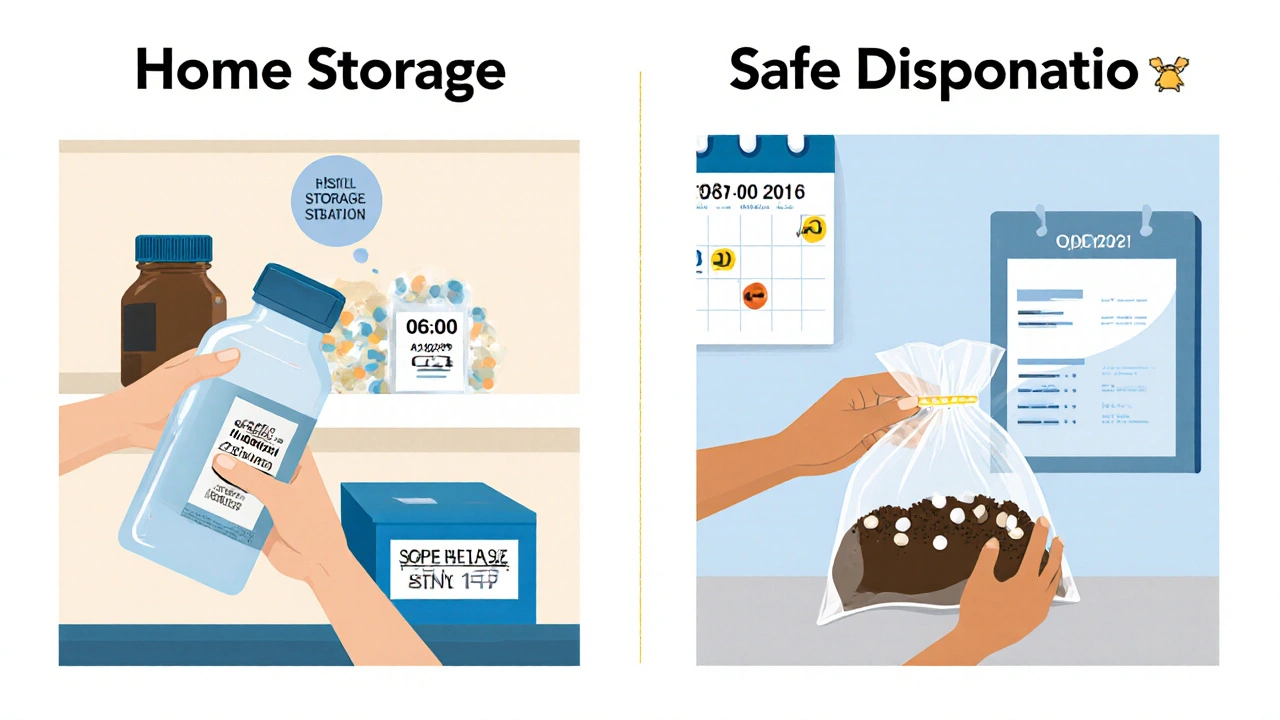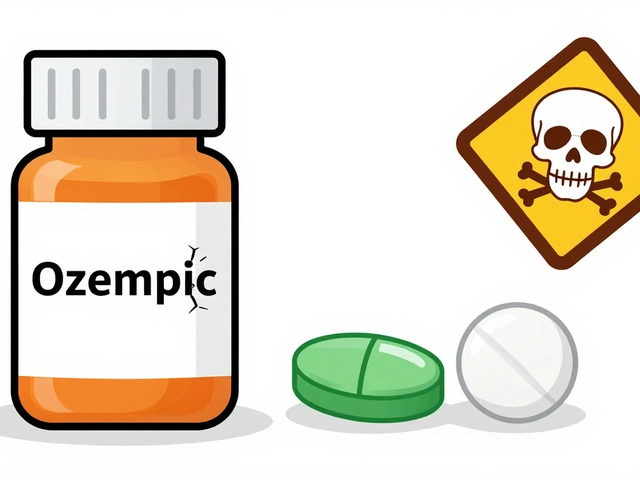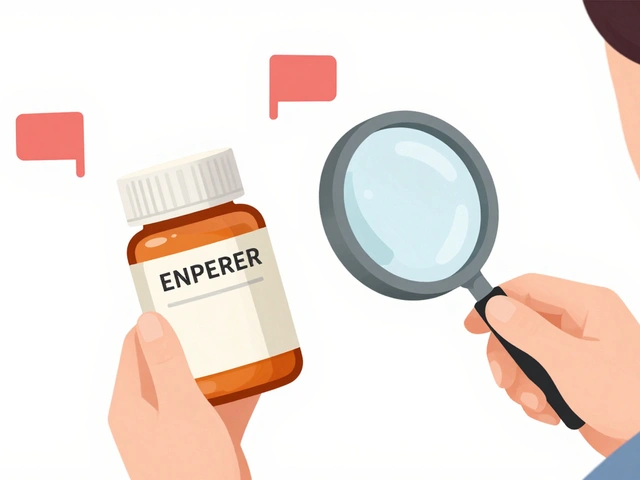
Medication Expiry Calculator
Calculate Expiration Date
Enter the date you opened your Clarithromycin bottle to determine when it expires. This tool follows UK guidelines for antibiotic storage and disposal.
When you’ve been prescribed Clarithromycin is a macrolide antibiotic used to treat a range of bacterial infections, from pneumonia to skin infections. Keeping it effective and keeping the environment safe both start with how you store it at home and how you get rid of it when it’s no longer needed.
Quick Summary
- Store Clarithromycin at 20‑25 °C (68‑77 °F) away from humidity.
- Keep the original bottle tightly closed and out of reach of children.
- Never flush tablets; use a pharmacy take‑back program or follow NHS guidelines for household disposal.
- Check expiry dates regularly; discard any cracked or discolored tablets.
- Document the disposal date for future reference.
What is Clarithromycin?
Clarithromycin belongs to the Antibiotic family, specifically the macrolide class. It works by stopping bacterial protein synthesis, which halts growth of the infection. In the UK it’s commonly prescribed for community‑acquired pneumonia, sinusitis, and H. pylori eradication regimens. Because it’s taken orally, patients handle the tablets or suspension directly, which makes storage and disposal a personal responsibility.
Why Proper Storage Matters
Temperature and moisture are the two biggest enemies of drug stability. The clarithromycin storage guidelines from the British Pharmacopoeia state that the tablet should remain below 30 °C and protected from humidity. Exposure to heat can cause the active ingredient to break down, reducing potency and potentially fostering antibiotic resistance if sub‑therapeutic doses are taken.
Additionally, keeping the medication out of children’s sight prevents accidental ingestion, a leading cause of pediatric poisoning. The National Health Service reports that more than 30,000 medication‑related incidents involve unsupervised access at home each year.

Step‑by‑Step: Safe Storage at Home
- Choose the right spot. Store the bottle in a cool, dry drawer or cabinet-think pantry or a kitchen cupboard away from the stove.
- Keep the original container. The blister packs are designed to protect each tablet from light and moisture. Transferring to a pill organizer can expose the drug to air.
- Tighten the lid. A loose cap lets humidity in. If the lid seems worn, replace the bottle with a clean, airtight container and label it clearly.
- Child‑proof the area. Use a high shelf or lockable drawer. If you have toddlers, consider a dedicated medication lock box.
- Monitor expiration dates. Write the date you opened the bottle on the label. Most Clarithromycin tablets stay stable for up to two years if unopened, but once opened the recommended use window shortens to about 12 months.
- Check for damage. Reject any tablets that look cracked, faded, or have an odd smell. These are signs of degradation.
Step‑by‑Step: Safe Disposal When the Course Ends
Unused or expired antibiotics should never be thrown directly into the trash or flushed down the toilet. They can enter water supplies and contribute to resistant bacteria. Follow these UK‑specific pathways:
- Return to a pharmacy. Most community pharmacies participate in the Medication Take‑Back Program. Simply drop the sealed bottle in the designated collection bin.
- Use NHS advice. If a pharmacy isn’t nearby, the NHS website offers a printed disposal leaflet you can attach to the package and place in household waste - but only after crushing the tablets and mixing them with an unappealing substance like coffee grounds.
- Household trash (last resort). If you must use regular waste, seal the medication in a plastic bag, crush the tablets, and place them in a non‑recyclable container. Do not place liquid suspensions in drains.
- Document the date. Jot down the disposal date on a calendar. If you ever need to confirm compliance for a medical audit, you’ll have proof.
Comparison: Clarithromycin vs. Amoxicillin Storage & Disposal
| Aspect | Clarithromycin | Amoxicillin |
|---|---|---|
| Recommended temperature | 20‑25 °C, avoid humidity | 15‑30 °C, less sensitive to humidity |
| Shelf life after opening | ≈12 months | ≈6 months |
| Disposal method (UK) | Pharmacy take‑back preferred | Pharmacy take‑back preferred |
| Environmental impact if flushed | High - macrolides persist in water | Moderate - β‑lactams break down faster |
Quick Checklist Before You Finish Your Course
- Are tablets stored in a cool, dry place?
- Is the bottle tightly sealed?
- Have you kept the medication out of children’s reach?
- Did you note the expiry date?
- When the prescription ends, will you use a pharmacy take‑back box?
Frequently Asked Questions
Can I keep Clarithromycin in the bathroom cabinet?
It’s not ideal. Bathrooms often have high humidity which can degrade the tablets. Choose a dry kitchen drawer or bedroom cabinet instead.
What should I do with a half‑finished bottle?
If you have enough pills left for a full course, continue using them. Otherwise, return the remainder to a pharmacy for safe disposal - many will accept partially used containers.
Is it safe to crush the tablets before throwing them away?
Yes. Crushing makes accidental ingestion harder and helps the drug mix with an unappealing substance before it reaches waste collectors.
Do I need to wear gloves when handling expired medication?
Gloves aren’t required for solid tablets, but they can provide extra protection if you’re dealing with a liquid suspension.
Can I donate unused Clarithromycin to a charity?
No. Regulations prohibit redistributing prescription antibiotics. The safest route is a take‑back program.
Following these steps protects your health, keeps your family safe, and reduces the risk of antibiotic resistance spreading in the community. Take a few minutes now to audit your medication cabinet - a little effort today prevents bigger problems tomorrow.




Caroline Keller
October 18, 2025 AT 22:45We all share the same planet and it’s our duty to keep medicines out of kids’ reach and out of the water supply.
dennis turcios
October 23, 2025 AT 14:02The guide lists the obvious steps but fails to mention that many pharmacies don’t actually accept partially used containers, which means the “take‑back” advice is often impractical for most patients. Moreover, the temperature recommendation of 20‑25 °C is a generic range that doesn’t account for seasonal fluctuations in a typical UK home.
Felix Chan
October 28, 2025 AT 04:18Hey, that’s a good point! If your local pharmacy can’t take the leftover pills, just follow the NHS leaf‑let instructions-crush the tablets, mix them with coffee grounds, and seal them in a bag before tossing them in the regular trash.
Thokchom Imosana
November 1, 2025 AT 19:34It is utterly baffling how the mainstream medical establishment continues to downplay the insidious ripple effects of improper antibiotic disposal, a fact that is conveniently omitted from most public health brochures. When you think about it, every tablet that ends up in a landfill or, worse, leaches into groundwater, becomes a silent vector for resistance genes that can be picked up by opportunistic bacteria, turning harmless microbes into formidable foes. The pharmaceutical industry, funded by massive corporate interests, has a vested interest in maintaining the status quo because any disruption to the supply chain-such as a mandated take‑back program-could potentially affect their bottom line. Moreover, the so‑called “pharmacy take‑back” bins are often placed in affluent neighborhoods, leaving under‑served communities to rely on the inadequate “trash” method. This disparity is not an accident; it is a calculated outcome of policy decisions that prioritize profit over public health. In addition, the government’s guidance to crush tablets and mix them with coffee grounds is a half‑hearted solution that does little to neutralize antibiotic activity, as many compounds remain stable even after mechanical disruption. What we need is a centralized, government‑funded decontamination facility that can safely incinerate pharmaceuticals, but these proposals are routinely dismissed as “costly” by budget committees. The irony is that the cost of antibiotic resistance to the healthcare system far exceeds the upfront investment required for proper disposal infrastructure. On top of that, there is a conspiratorial element to the narrative: the narrative that “the public can handle disposal responsibly” is propagated by a coalition of pharmaceutical lobbyists and media outlets that aim to shift responsibility away from corporate accountability. If you look at the data from European wastewater treatment plants, you will see measurable concentrations of macrolides like clarithromycin persisting despite standard filtration processes, indicating that current disposal practices are insufficient. The fact that the NHS still recommends a method that involves merely “crushing and discarding” is a clear sign of regulatory negligence. As a citizen, you ought to demand transparency regarding the fate of these compounds once they leave your hands. In the meantime, protecting your family by storing antibiotics in a child‑proof, temperature‑controlled environment is a small but essential step in a larger battle against an emerging superbug crisis. Ultimately, the onus should not be on the individual patient to solve a systemic failure; it should be on governments and corporations to provide safe, accessible, and scientifically sound disposal options.
DHARMENDER BHATHAVAR
November 6, 2025 AT 10:51Thank you for the thorough analysis; concise action steps remain crucial: store the medication in a locked cabinet below 25 °C and arrange a pharmacy drop‑off before the expiry date.
Christian Georg
November 11, 2025 AT 02:07For those who can’t get to a pharmacy, the NHS leaflet suggests sealing the crushed tablets in a zip‑lock bag, mixing them with an unappealing substance like coffee grounds, and then placing the bag in a non‑recyclable container before tossing it in the regular waste 🙂
Christopher Burczyk
November 15, 2025 AT 17:24The stability data for clarithromycin indicate a shelf‑life of up to two years unopened, but once the bottle is opened the active pharmaceutical ingredient begins to degrade at a rate of approximately 5 % per month if exposed to humidity above 60 % relative humidity.
Nicole Boyle
November 20, 2025 AT 08:40From a pharmaco‑kinetic standpoint, maintaining the drug’s integrity hinges on controlling both the micro‑environmental temperature and moisture vapor pressure within the storage container, which essentially mitigates hydrolytic degradation pathways.
ashanti barrett
November 24, 2025 AT 23:56That makes sense; I’ll keep an eye on the humidity levels in my pantry to ensure the tablets stay potent throughout the prescribed course.
Leo Chan
November 29, 2025 AT 15:13Great tips everyone-let’s all do our part, lock up the meds, note the dates, and drop them off when we’re done. Small actions add up to big victories against resistance!
jagdish soni
December 4, 2025 AT 06:29indeed every tiny effort is like a ripple in a vast ocean the collective habit of proper disposal could one day turn the tide against a looming superbug crisis
Monika Bozkurt
December 8, 2025 AT 21:45Adhering to these protocols safeguards both patient outcomes and environmental health.